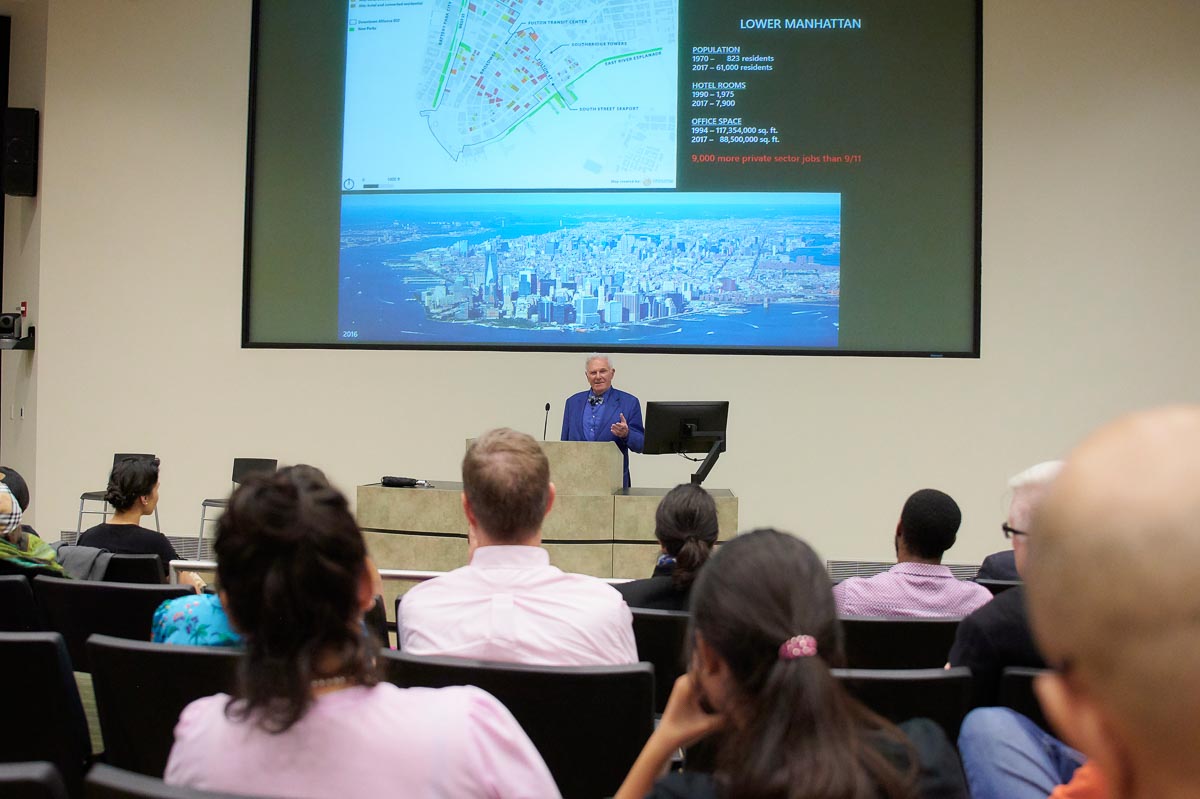"America is changing and it is changing rapidly in front of our eyes," Alexander Garvin, author of "The Heart of the City" and professor at the Yale School of Architecture, said at the Kinder Institute Urban Reads lecture Tuesday evening. "Cities have more than one downtown. Atlanta has three, New York City has seven or eight. And what many people in Houston don't know is that you have at least three or four."
But the vibrancy and success of these and other downtowns varies. According to Garvin, cities can experience one of three possible trajectories, including continuing decline (like the population loss witnessed in Detroit following the 1950s), continuing growth (like Houston's Uptown area that he said has experienced significant changes within the built environment) or downtown resurgence (like Lower Manhattan, which has shifted from a single-function business area towards an area catering to businesses and residents).
How and why are our cities' downtowns changing? According to Garvin, there are four major reasons: technology, transportation, population and lifestyle.
"You have to understand what those four things mean and that those changes do not automatically happen," Garvin said. "Cities don't change themselves. Somebody has to do it, whether a person or an institution."
Technology can change a city's landscape in many ways, but Garvin focused on the efficiency of space that technology has offered downtowns. A single worker's space requirement has been reduced from 500 square feet in the 1970s to 150 square feet today because there are no longer things like filing cabinets or filing clerks anymore. Companies started taking up less room and more office space became available. Additionally, shipping and manufacturing companies began to move out to the city's outskirts when land prices rose.
With the vacancies in office, manufacturing and shipping buildings, developers began to renovate and recreate those newly-opened spaces for other uses like retail and residential.
With more office spaces and former factory spaces being redeveloped into residential and retail spaces, more people headed into downtowns to not just work, but also to live. New York City's professional population in Lower Manhattan in the 1970s was more than 400,000 and the residential population was 823 people, according to Garvin. In 2016, those figures have changed to 233,000 jobs and 61,000 residents.
Transportation can also change an area into more of a downtown, Garvin said, and Denver is an example of this. In 2004, the city approved an increase in its sales tax to create a rail system from the city's major suburbs and airport to the city center, specifically downtown's 16th Street. This rail system is also connected to a free bus system that runs throughout Denver's downtown.
In a day-to-day outlook, this system offers a transportation route that wouldn't have been offered without the city investing in the transportation system.
"So people park in a cheaper garage [outside of downtown], walk to 16th Street, get on the bus and go to their office. At lunchtime, they go downstairs and they take the bus to lunch," Garvin said. "In the evening, they go downstairs and take the bus to meet their date or to go to the theater. Everything—the state capital, the university, the convention center, the performing arts center, the three athletic facilities—everything is in walking distance, all of that." Garvin suggested Houston's Uptown has the potential for a similar situation once METRO's Bus Rapid Transit system is completed in the area.
Finally, urban residents' lifestyles have changed and their demands for a good downtown area have changed. "We have bike shares now. We have jogging areas. We do not live the way people lived in the 1950s when I was a small boy," he said.
Due to the demands of the people living and working in downtowns, cities, organizations and districts were—and are—held to a higher standard. Through developing of Business Improvement Districts, according to Garvin, cities were able to make the district safer, cleaner and more attractive. Across the country, there are more than 1,400 BIDs and they started with "a revolt by the people downtown—the people who work there, the people with property there, the people who had businesses there."
Garvin's top examples of successful BIDs in America are Dallas' Klyde Warren Park above the Woodall Rodgers Freeway, which connected two neighborhoods with a park rather than the freeway underneath the park; Cincinnati's Over-the-Rhine neighborhood, which bought up historic buildings to renovate them into music halls, restaurants, theaters and housing; and New York City's Hudson Yards, which has changed from the city's "Death Avenue" to a flourishing mixed-use development after a subway extension.
Garvin suggests a national standard for BIDs to operate throughout America: "First, continue to manage the public services, because if you don't manage them for the benefit of the people who get the services, they aren't going to be managed very well. Secondly, invest in a public development corporation, like Cincinnati did, which would buy private property when necessary and renovate buildings. Third, do tax increment financing, to pay for the changes in the public realm. And fourth, endow a program to make the public realm terribly useful for people, like in Dallas."
In the end, these improvements require resources. "Investment has to be made," Garvin said. "Every government entity is complaining that they don't have enough money. When I hear that, my reaction is, 'Like hell. It's what you're spending your money on. Is that the right thing?'"

